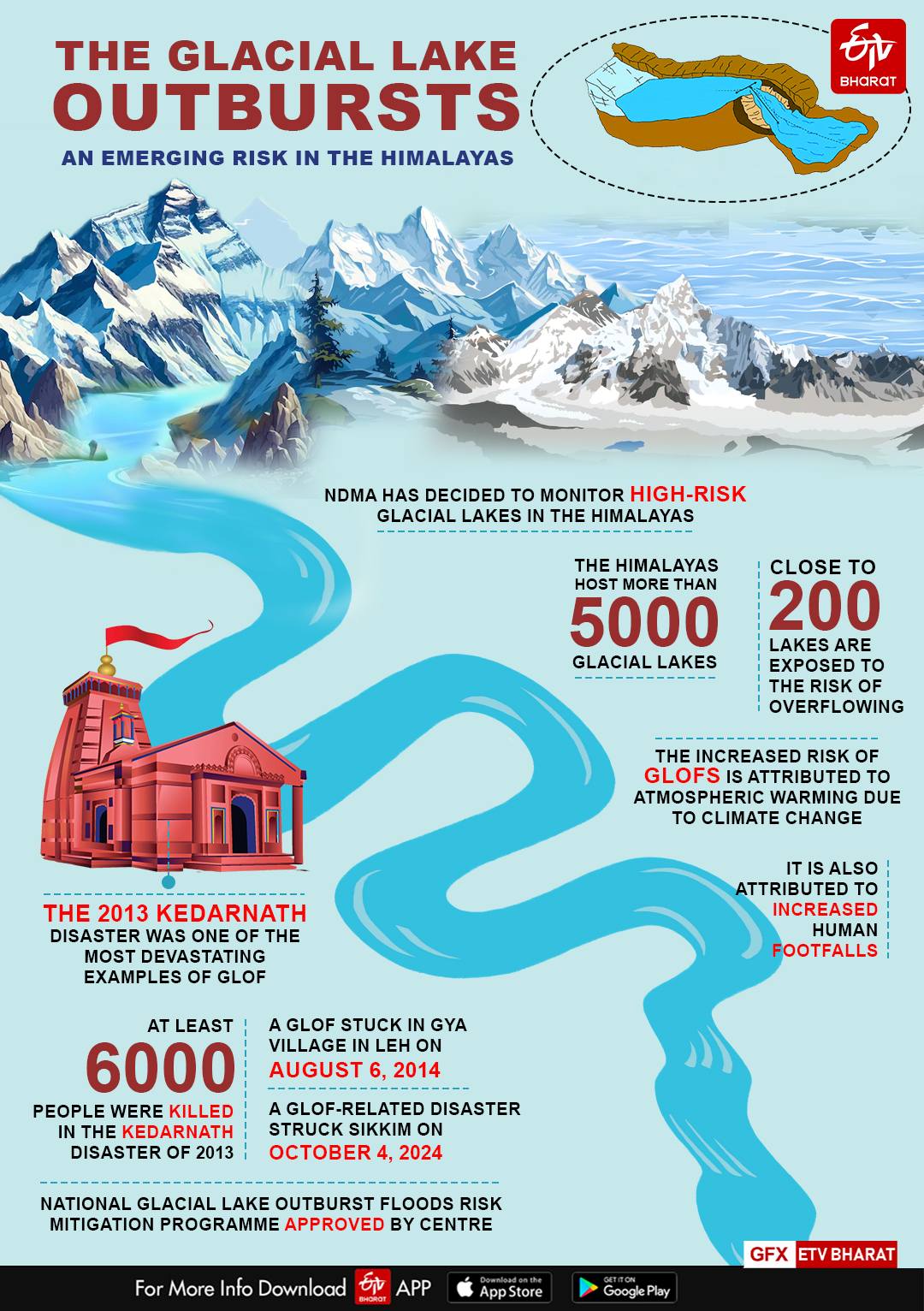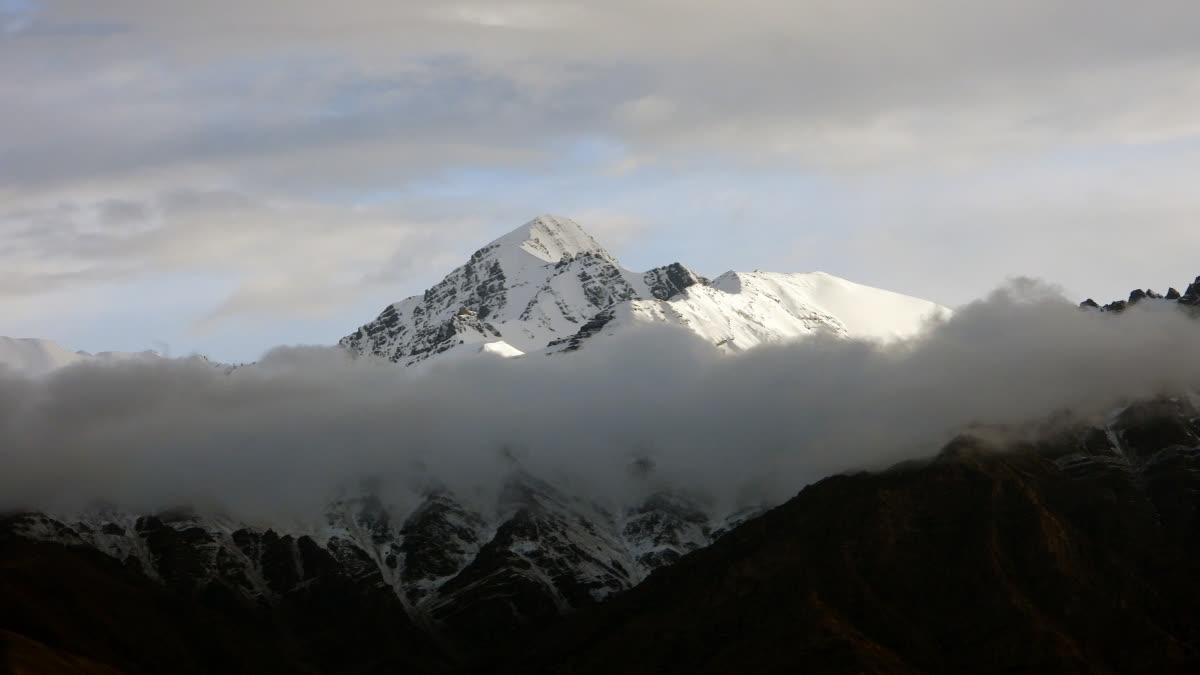According to recent press reports, the National Disaster Management Authority (NDMA) has decided to monitor the high-risk glacial lakes in the Himalayas. This decision must have emanated from the fact that glacial lake outbursts are now emerging as a major risk in the Himalayas. The Himalayas host more than 5000 glacial lakes and close to 200 lakes are now exposed to the risk of overflowing. The increased risk of GLOFs is attributed to atmospheric warming due to climate change and increased human footfalls.
A glacial lake outburst flood, or as it is known in scientific literature by the acronym GLOF, usually results in more damage and destruction than a flood caused by excess rainfall alone. Several GLOF disasters have occurred in the recent past. The 2013 Kedarnath disaster was one of the most devastating examples of GLOF caused by the overflowing glacial lake up in the mountain, with 6,000 fatalities.

A GLOF struck Gya Village, Ladakh at midnight on 6 August 2014, destroying bridges, houses and farms. This occurred not as a spillover due to avalanches or landslides but due to the thawing of ice cores, allowing water to drain through subsurface channels. On February 7, 2021, another somewhat similar mass flow descended the Rishiganga and Dhauliganga Valleys in Chamoli, Uttarakhand, killing more than 200 people and damaging two hydropower projects.
Unlike the 2013 Kedarnath flash flood, the Ladakh and Chamoli incidents show no evidence of a glacial lake spillover at the top of the mountain. Still, all these incidents are related at a fundamental level, for their triggering mechanism – the untimely melting of permanent ice, otherwise called permafrost. Mountain permafrost is the ice in the cracks and crevices between the rocks that hold them together and help to stabilise steep slopes.
The thawing of mountain permafrost – the glue that binds the fractured rock to the surface ice - triggers the erosion of the mountain slopes. The warmer temperatures in the last few decades must have been the cause for the permafrost to melt.
A GLOF-related disaster that struck Sikkim in the early hours of Wednesday, October 4, 2023, ended up killing at least 40 people and many more are reported to be missing. Heavy rains caused the glacial South Lhonak Lake in Sikkim to outburst causing devastating floods in the downstream areas. The surge of floodwaters flowing into the Teesta River in Lachen Valley was so intense that it washed away several bridges and roads and it rammed the biggest hydroelectric project, the Teesta-III Dam in Chungthang in Sikkim, causing part of it to give away.
The flash flood was caused by a cloudburst resulting in the Lhonak glacial lake, located 5,200 metres above sea level, to overtop the impounding moraine, eventually eroding it to form an outlet. The Sikkim disaster is a repeat of such events in the Himalayas – the increasing risk caused by the upward trend in global warming and sustained melting of mountain glaciers and permafrost. Combined with unregulated constructions, hydroelectric projects and anthropogenic activities, these events evolve into massive disasters.
The Himalayan contain the largest volume of snow and ice, outside the Polar Regions. The ‘Third Pole', as it is also referred to, has a huge repository of glaciers – the point of origin of some of Asia’s major rivers. It is also a prime regulator of the general global climate in Asia. A billion people living downstream of these rivers in China, India, Pakistan, and other Southeast Asian countries, depend on the Himalayas and the Tibetan Plateau to meet their water needs. Scientific studies inform us that this third type of force, now recognised as the chief driver of global warming impacts the natural balance and accelerates environmental change in the mountain range.
Nearly one billion people living downstream in China, India, Pakistan and Southeast Asia depend on the Himalayas and the Tibetan plateau for water. Recent projections indicate that the region around Mt. Everest may lose 70-99 per cent of glacier volume by the year 2100 due to warming caused by greenhouse gas emissions. The heavy vehicular emissions due to pilgrim tourism and the rise in black carbon or soot could also result in glacial melting and environmental degradation. The studies show that the black carbon alone causes at least 30% of the total glacier melt in the Himalayas. These findings portend a very alarming situation.
The studies show that sustained glacier melt produces glacier lakes in the Himalayas, dammed by potentially unstable moraines – the loose debris transported by glaciers. These lakes are prone to outbursts triggered by ice or debris falls, earthquake shaking or overtopping waves generated by intense rainfall. The erosion of impounding barriers happens within minutes or hours, releasing sediment-laden water rushing downstream, and destroying everything in its wake.
The studies also indicate that glacier lakes are much larger in number and have occurred in clusters in the Central and Eastern Himalayas since 1990, compared to the other parts of the mountain range. Rock avalanches are initiated at higher elevations where the slopes have more mountain permafrost exposed to changes in long-term temperatures.
The press reports indicate that the National Glacial Lake Outburst Floods Risk Mitigation Programme, approved by the Union Government on July 25, will evaluate the volume, depth and longitudinal profiles of six lakes in Sikkim, identified as high-risk, to start with. The study will conduct a geophysical assessment of these moraine dams to assess their stability and risk factors using an Electrical Resistivity Tomography Survey and Ground Penetrating Radar Survey.
Finding means of lowering the water volume in glacial lakes is a way of mitigating the risk of GLOFs. Although an improved glacial lake inventory is available now, bathymetric data of these lakes are required for a more precise estimation of lake volumes for risk analyses.
Mapping potentially dangerous glacial lakes and assessing their GLOF hazard should lead to devising appropriate methods to mitigate the impact of such disasters in the area. The increasing trend in human habitations and widespread construction of engineered structures like hydro-electrical projects, bridges, tunnels and roads in the Himalayas result in expanded human sphere exposure to cryosphere hazards. There should be a serious rethinking of the current developmental models for the Himalayan states, including unregulated pilgrim tourism in the context of climate change, increased disaster potential and vulnerability.
(Disclaimer: The opinions expressed in this article are those of the writer. The facts and opinions expressed here do not reflect the views of ETV Bharat)



